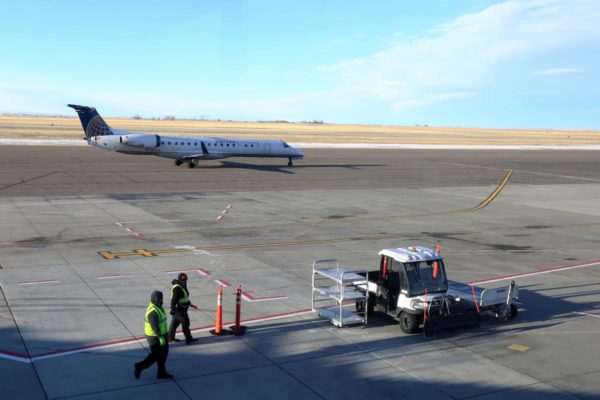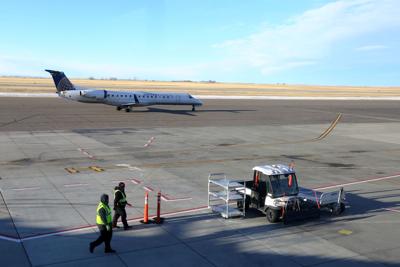Local pilots decry federal changes to flight routes

Two workers leave the ramp after overseeing a United Express flight at Casper/Natrona County International Airport on Monday. Federal changes to flight routes in Wyoming have some local pilots concerned.
Cayla Nimmo, Star-Tribune
A cost-saving shift by the Federal Aeronautics Commission to GPS-guided landings at airports around the Mountain West has elicited the concern of a number of airplane pilots based in Casper, who fear the proposed elimination of more than a dozen analog routes could cause significant problems for air transportation around the state.
Long guided by a network of extremely high-frequency, short-range ground-based systems known as VORs, pilots in the Rocky Mountains will soon go the way of the rest of the country and come to rely heavily on the same GPS-guided navigation systems promoted by the FAA since the technology’s introduction in the early ‘90s.
It’s a significant step for pilots in the region, who have long relied on the older, more inexpensive systems already in place for navigating the mountainous terrain, and one long pursued by a bureaucracy seeking ways to make air travel as streamlined, efficient and responsive as possible.
“It’s been a quantum leap forward,” said Joe MacGuire, a local airline pilot and a Republican member of the Wyoming House of Representatives.
Some like MacGuire, however, see holes in the FAA’s vision.
A big piece of that process has involved the gradual decommissioning of VORs across the country, which – while technically obsolete – are still heavily relied upon by pilots in the low-flight volume and difficult weather states of the Mountain West, where GPS-guided flight systems are prohibitively expensive for those without them and prone to occasional mishaps for those who do.
This change, Casper-based corporate pilot and 45-year flight veteran Dallas Chopping said, could also be a potentially dangerous one: though the number of VOR approaches proposed for elimination by the FAA – at just over two dozen statewide – seems small, they could present a significant liability for pilots in a rare event when the GPS systems fail or are disrupted, potentially creating risks for commercial pilots, emergency responders and even the National Guard, who often provide a critical role in search-and-rescue operations around the state.
Renny MacKay – policy director for Gov. Mark Gordon – told the Star-Tribune Wednesday that the state is aware of the concerns and is currently working with the National Guard and others to ensure they are aware of the proposed decommissioning and that they are still considering all the implications the proposal will have.
Those who know the sky well, however, see immediate problems.
“The approaches they want to eliminate are based off of the VORs that will be kept up and running, but you’re taking a tool away from them,” said Chopping. “It’s kind of like saying you need a map to drive on the interstate, but then they stop printing the maps. The bottom line is that once an approach is gone, if the GPS disappears or goes down for an extended period, there’s no ambulance, there’s no air service for most of the country, indefinitely.”
And it’s all been happening without publicity. MacGuire, a member of Casper’s airport board, said he first became aware of the elimination of 25 approaches around the state only after being informed that one approach leading to the Casper/Natrona County International Airport would be eliminated – a much quieter process than that employed by the FAA when decommissioning VOR facilities in the past.
That decision could have ripples throughout the state: By eliminating even one VOR, a pilot has one fewer backup option to guide them to the runway during rough weather conditions, creating more liability for airline carriers and rescue operators whose GPS systems – for whatever reason – aren’t operating accurately.
When the FAA only requires 45 minutes’ worth of excess fuel, this can be particularly problematic during emergency scenarios where pilots are unable to land due to a failure in the system and need an alternative landing site, said Casper-based pilot Barb Bentzin.
“In Wyoming, that will barely get you to another airport with decent weather,” she said. “If you start picking and choosing where you can go because these approaches are not available, now you’re really going to have to carry a lot more fuel to get where you’re going. In the case of the airlines, it means you’re kicking passengers off.”
“As long as the GPS system is working, you’re fine,” added Chopping. “But if you’re kicking out all the infrastructure underneath it and the GPS goes out for whatever reason, all of these communities will not have life flights, they won’t have airports … we’re taking the life preservers off the ship. And the communities don’t realize this is happening.”
Already, the Casper Chamber of Commerce is mobilizing its membership to respond out of concerns the changes could impact commercial air traffic. In a message to its membership on Wednesday, the Chamber urged its members to weigh in on the potential decommissioning prior to the Jan. 15 deadline set by the FAA, highlighting a number of examples where the decommissioning of the route could impact the local economy.
Last winter, for example, one of the local airport’s ground-based systems was disrupted, causing both airlines that provide regular service to the area to cease operations.
“Casper still has a lot of aircraft – including our airlines – that do not have approach certified GPS,” Erin Morgan, the chamber’s executive director, wrote in the statement. “The problem is that if we have a national emergency, the first thing that the DOD will do is turn off our access to GPS. (The current trend is for terrorists to fly drones armed with explosives using GPS guidance to a target).”
“The FAA will argue that it is a cost savings,” she added. “However, for Casper, there is no advantage to losing the approach!”
Public comments can be sent by email to AMC-ATO-IFP-Cancellations@faa.gov. The deadline is Jan. 15.












